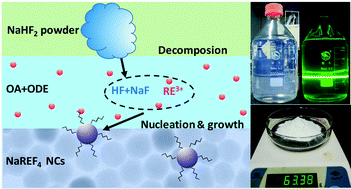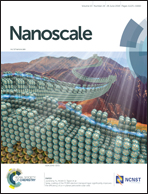Large-scale synthesis of uniform lanthanide-doped NaREF4 upconversion/downshifting nanoprobes for bioapplications†
Abstract
Lanthanide (Ln3+)-doped NaREF4 (RE = rare earth) nanocrystals (NCs) are one of the most widely studied upconversion and downshifting luminescent nanoprobes. However, the size and optical performance of the Ln3+-doped NaREF4 NCs produced by the available lab-scale synthesis may vary from batch to batch, which inevitably limits their practical bioapplications. Herein, we report the synthesis of uniform Ln3+-doped NaREF4 NCs via a facile solid–liquid-thermal-decomposition (SLTD) method by directly employing NaHF2 powder as a fluoride and sodium precursor. The proposed SLTD strategy is easy to perform, time-saving and cost-effective, making it ideal for scale-up syntheses. Particularly, over 63 g of β-NaGdF4:Yb,Er@NaYF4 core/shell NCs with narrow size variation (<7%) were synthesized via a one-pot reaction. By virtue of their superior upconversion and downshifting luminescence, we employed the synthesized core/shell nanoprobes for the in vitro detection of prostate-specific antigen with a limit of detection down to 1.8 ng mL−1, and for in vivo near-infrared imaging with a high signal-to-noise ratio of 12. These findings may pave the way for the commercialization of Ln3+-doped nanoprobes in bioassay kits for versatile clinical applications.

- This article is part of the themed collection: International Year of the Periodic Table : Lanthanides for Precision Therapy and Beyond


 Please wait while we load your content...
Please wait while we load your content...